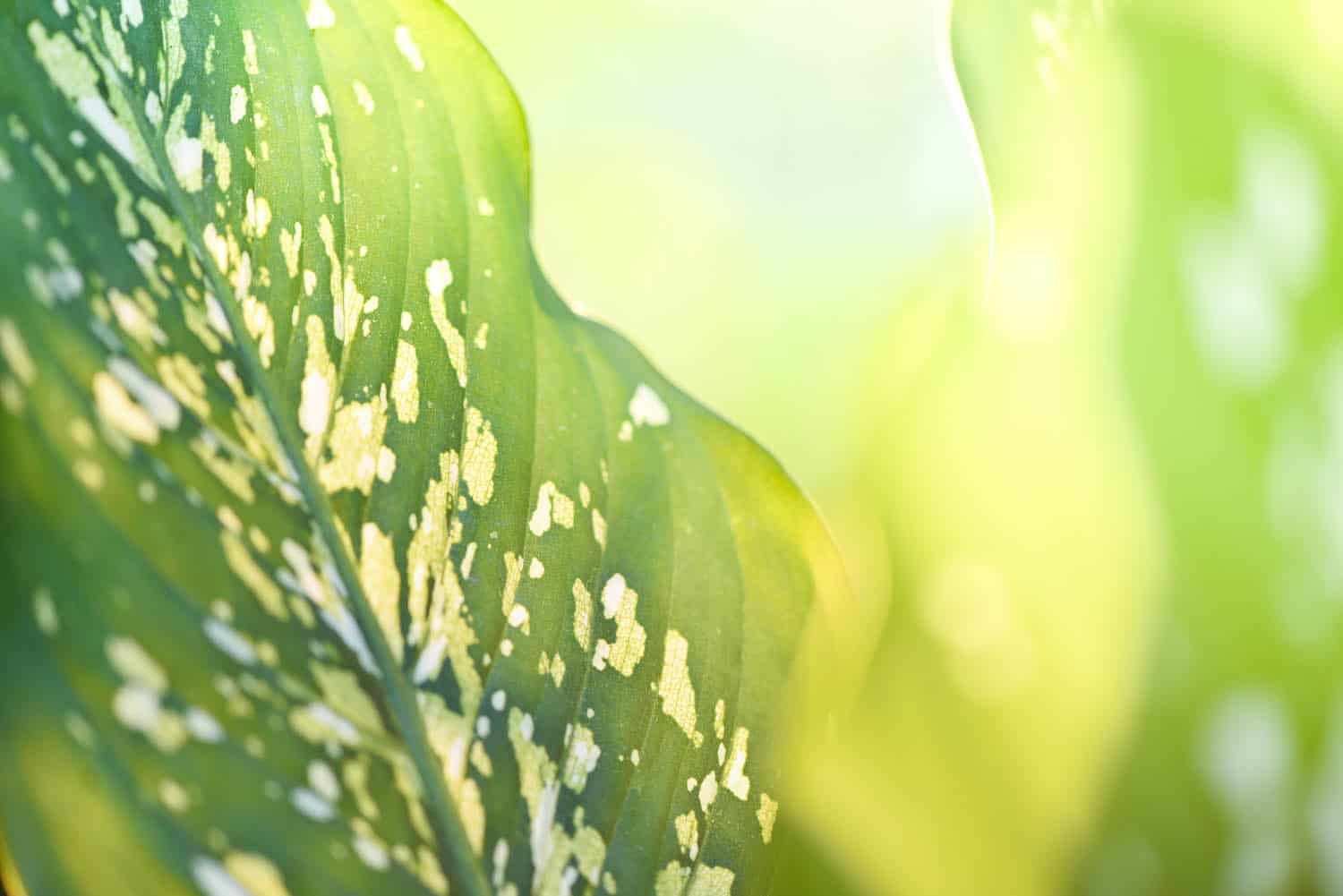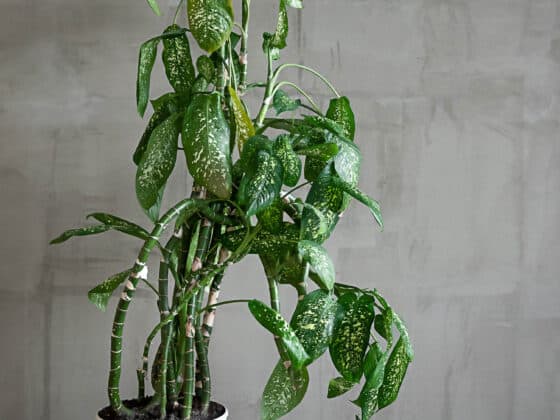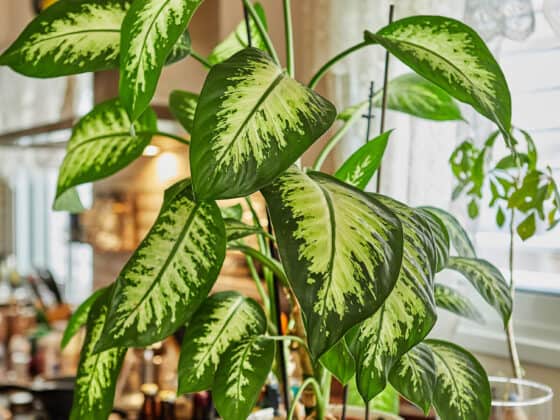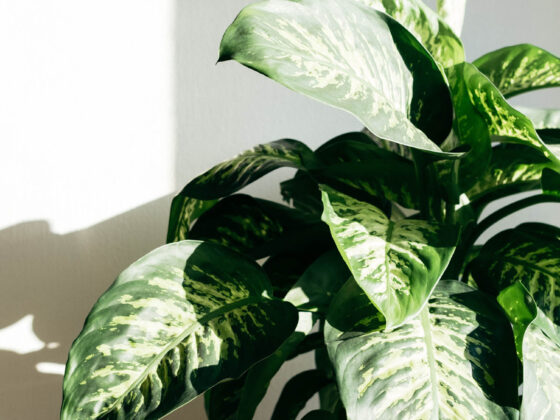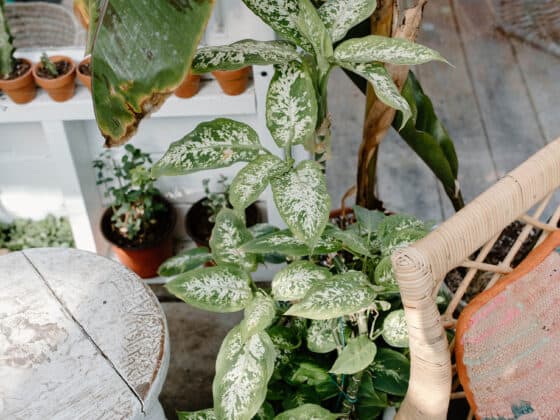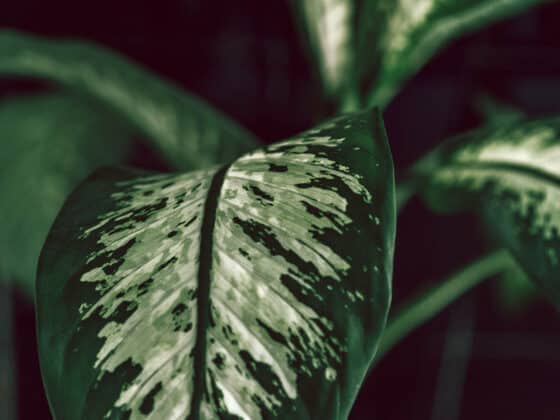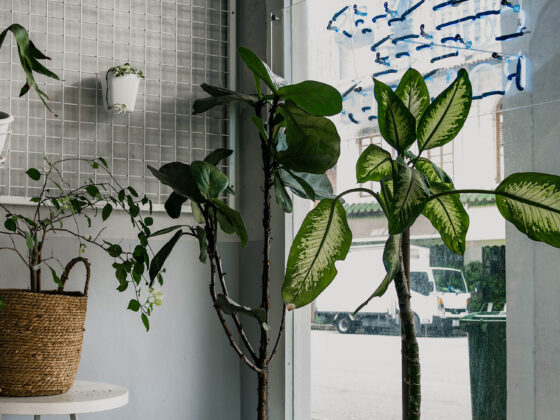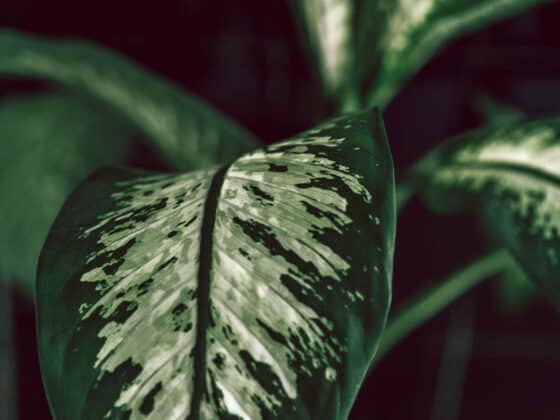The conversation about Dieffenbachias tends to focus on their beautiful foliage, to the point that you might wonder if these plants even grow flowers. The answer is yes – Dumb Canes can produce blooms, even if they don’t get as much attention as the leaves. This article will give you a detailed overview of the flowering behavior of Dieffenbachias.
Dumb Canes rarely flower when raised as houseplants, and when they do, their blooms aren’t very showy or fragrant. They’re similar in shape to the blossoms of a Peace Lily, but without any bright coloration to help them stand out from the rest of the plant. Unless you find their smell irritating, you don’t need to cut the flowers off until after they’ve withered.
A Dieffenbachia’s flowering cycle is designed to prevent self-fertilization, so if you only have one plant, you usually won’t be able to breed it without freezing some pollen for later use. Even then, it can be hard to predict when another blossom will emerge, so breeding these plants at home requires a fair amount of luck. In general, only mature, healthy Dumb Canes that get lots of indirect sunlight will flower.
What Does A Dumb Cane Flower Look Like?
Dieffenbachias are part of the Araceae or aroid family, which includes a considerable number of popular houseplants. Other notable examples include Anthuriums, Monsteras, Chinese Evergreens, and Philodendrons. Although many of these plants are prized for their foliage, the characteristic they all share is the structure of their blooms.
The true flowers of aroids are tiny, and they’re contained along a short, blunt spike called a spadix. In most cases, the spadix appears along with a modified leaf called a spathe which sits behind the spadix or partially encircles it.
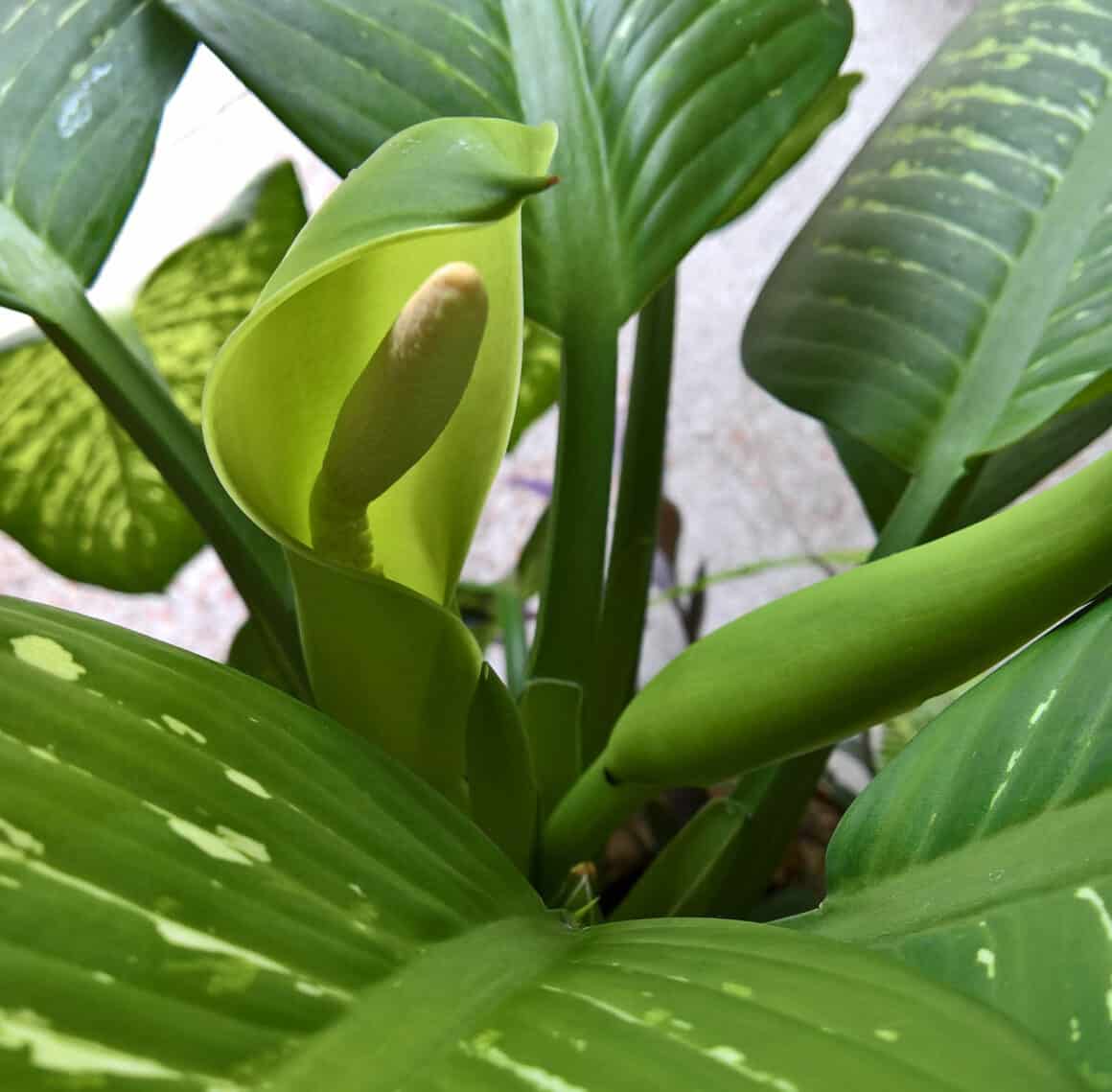
The combination of spathe and spadix is called an inflorescence, and it’s what most people mean when they talk about the “flower” of one of these plants. The confusion is understandable, especially since the spathe is often the most brightly colored part.
In Dumb Canes, the spadix is beige or pale yellow and points upright, resembling a small piece of baby corn. The spathe wraps around the lower section and flares out around the upper section like a hooded robe on a comic-book villain. The spathe is the same green as the plant’s other leaves, so it doesn’t catch the eye like the blooms of an Anthurium or a Peace Lily.
You can recognize an emerging inflorescence by its shape; the spathe will be wrapped around the spadix, forming a lumpy spike that looks a bit like a pea pod.
Are Dieffenbachia Flowers Fragrant?
The odor of Dumb Cane flowers can vary somewhat. Some have virtually no smell, while others give off an earthy musk that can be scented from across the room. We’ve seen the fragrance compared to dust, cucumbers, black pepper, and decaying wood. Most people don’t find it unpleasant, exactly, but it’s a smell that seems more at home on the mossy floor of an old-growth forest than in your living room.
It’s not surprising that a Dieffenbachia’s odor isn’t exactly fine-tuned for human nostrils; like many aroids, these plants are pollinated by beetles in the wild. The scent of musty leaf litter probably smells like lunch to these insect scavengers. It could be worse – some other aroids, like the enormous Titan Arum, mimic the smell of a rotting corpse to attract carrion-eating bugs.
Should You Cut Off Dieffenbachia Flowers?
Since you didn’t buy your Dumb Cane for its blooms, you might be wondering if you should just trim them off.
The answer is: it’s up to you. If you don’t find the inflorescences interesting, there’s no real reason to leave them hanging around. Snipping the flower off before it opens can help the plant save its energy for growing bushy foliage.
There are scattered reports that a Dieffenbachia stalk may go into decline after it finishes flowering, but this doesn’t seem to be all that common. These observers may just be seeing ordinary senescence (or the natural dying back of old foliage) and assuming it’s related to the bloom – after all, Dumb Canes don’t usually start flowering until they’re fairly mature.
Fortunately, by the time your Dieffenbachia is ready to blossom, it will usually have produced some side shoots that can keep going if the main stalk starts to wither.
Even if you like the look of the inflorescence, you should cut it off once it starts to dry up and fade. Otherwise, it may develop mold, which could be bad for both your plant’s health and yours.
When you’re trimming a Dieffenbachia flower, don’t forget to disinfect your pruning scissors, and always wear gloves to protect your skin from the potentially irritating sap.
How to Get a Dumb Cane to Flower
Those who do find Dieffenbachia flowers attractive will be disappointed to learn that there are few reliable ways to get these plants to bloom. Their flowering is rare and unpredictable. People who’ve been growing Dumb Canes for decades will jump onto houseplant forums to post pictures of a single emerging inflorescence.
If you’re interested in seeing a Dieffenbachia bloom, you might want to try purchasing an older plant instead of a young clone. These plants don’t typically flower until they’re at least a few years old.
Sunlight is also crucial for flowering in most aroids. Your Dieffenbachia can survive dim lighting, but it probably won’t produce an inflorescence unless it’s getting a healthy dose of bright, indirect light. Consider moving your Dumb Cane into an east-facing window or a south-facing one that’s covered with a sheer curtain (these plants can’t handle direct sun). Our article on lighting for Dieffenbachias will give you a more detailed overview of their energy needs.
The most effective way to stimulate flowering is by spraying a Dumb Cane with the plant growth hormone gibberellic acid. A single misting with a solution of 250-1000 parts per million should do the trick, though it usually takes a few more months for inflorescences to emerge.
Saving Pollen From Dumb Cane Flowers
Are you hoping to breed your Dieffenbachia and raise new plants from seed? We won’t say it’s impossible, but you’ve definitely got an uphill battle ahead of you.
It’s hard enough to get these plants to flower in the first place, but even if you do get an inflorescence, it won’t be able to fertilize itself. The male half of the spadix doesn’t start producing pollen until after the female portion has ended its fertile phase. Unless you have multiple blooms at once, you’ll have to save some pollen and wait for another flowering phase.
You can collect the pollen around 2-3 days after the spathe opens, at which point the upper part of the spadix should be covered in what looks like greenish-yellow fuzz. That dust is the pollen. Tap or brush it onto a piece of paper or aluminum foil (this may be easier if you snip the inflorescence off first).
Next, fold up the paper or foil into a little packet and seal it in an airtight plastic container such as a ziplock bag. Then stash it in the freezer. It’s often helpful to place a packet of silica gel beads into the container to soak up extra moisture. The pollen should last up to a year in dry, freezing conditions.
Pollinating Your Dieffenbachia
The next time your Dumb Cane blooms, you can open up your packet of stored pollen and smear it onto the inflorescence with a small paintbrush. Don’t delay – the fertile period for female flowers only lasts about a day after the spathe unfolds. The female flowers are on the lower part of the spadix, the part that’s mostly enclosed within the spathe. You’ll have to reach your brush down inside or peel open the leaf to reach them.
After you pollinate, you can increase the odds of successful fertilization by keeping your Dieffenbachia extra-humid. Some professional breeders will wrap the inflorescence in a wet paper towel and cover it with a plastic bag to seal in as much moisture as possible.
Around 3 or 4 weeks after pollinating, any flowers that you’ve successfully fertilized will turn green and begin to swell up. Over the next 4 or 5 months, they’ll develop into bright red berries, at which point they’re fully mature.
Each berry contains a single seed. After plucking them off the spadix, squeeze out the seeds and clean them off to keep mold or bacteria from growing inside any lingering goop. You should germinate the seeds right away, placing them on top of a moist and water-retentive growing medium – something heavy in peat moss or coconut coir.
Keep the seeds warm and humid while waiting for them to sprout. It’s often helpful to cover the containers with a plastic bag. If you’ve succeeded, you should see new seedlings popping up in 2 or 3 weeks!
Final Thoughts
Dieffenbachia flowers will never be the stars of the show, but they’re interesting in their own subtle way. If you want your Dumb Cane to blossom, keep it in good health, provide lots of indirect sunshine, and above all, be patient. If you’re lucky, your Dieffenbachia will reward you with some delicate new blooms.






